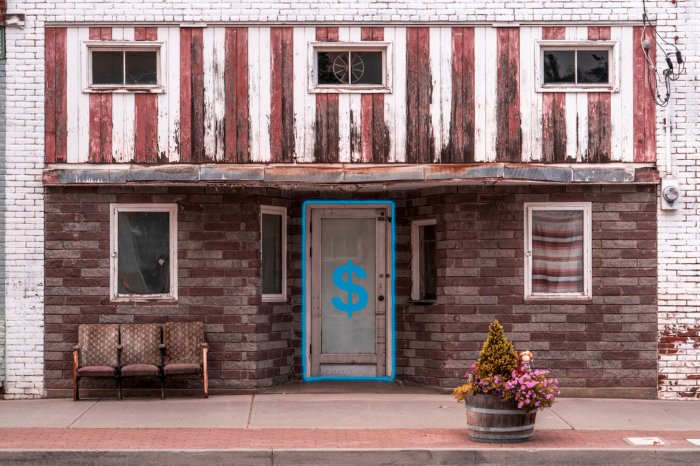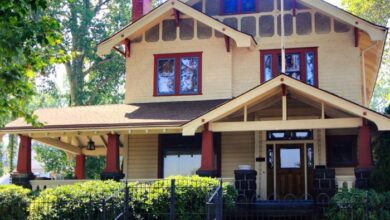What Makes A Neighborhood “High Potential” For Property Investors?
What Makes a Neighborhood “High Potential” for Property Investors? This question opens the door to understanding the intricate factors that elevate certain neighborhoods above the rest in the realm of real estate investment. Exploring this topic reveals a captivating array of economic, demographic, and infrastructural elements that contribute to a neighborhood’s allure for savvy investors.
High potential neighborhoods are often characterized by rising property values, strong community features, and favorable economic indicators. By delving into the nuances of these areas, investors can uncover valuable insights that inform their investment strategies and enhance their chances of success.
Defining “High Potential” Neighborhoods
Identifying a “high potential” neighborhood is crucial for property investors aiming to maximize their returns. This classification is based on various characteristics that indicate a neighborhood’s likelihood of experiencing significant property value appreciation over time. Understanding these factors can help investors make informed decisions and strategically position themselves in the real estate market.A neighborhood is classified as “high potential” based on several key characteristics, including its economic growth, demographic trends, and accessibility.
Investors should pay close attention to socioeconomic factors that contribute to property value appreciation, such as employment opportunities, rising incomes, and population growth. Furthermore, the significance of location cannot be overstated, as it plays a pivotal role in determining a neighborhood’s investment potential.
Characteristics of High Potential Neighborhoods
Numerous characteristics define high potential neighborhoods that attract property investors. These factors not only enhance the desirability of a location but also contribute to long-term value appreciation.
- Economic Development: Areas undergoing significant infrastructure improvements, such as new public transportation systems or commercial developments, often see an increase in property values.
- Employment Opportunities: Neighborhoods with a diverse job market and proximity to major employers tend to attract a steady influx of residents seeking employment.
- Demographic Trends: A growing population, particularly among young professionals and families, can lead to increased demand for housing, driving property values up.
- Community Amenities: Access to schools, parks, shopping centers, and healthcare facilities enhances a neighborhood’s appeal, making it attractive to potential buyers and renters.
- Safety and Low Crime Rates: Areas with lower crime rates tend to be more desirable for families and individuals, contributing to higher property values.
Socioeconomic Factors Contributing to Property Value Appreciation
Understanding the socioeconomic landscape is essential for evaluating a neighborhood’s potential for property investment. Various factors can influence property values, and recognizing these trends can provide insight into future growth.
- Income Levels: Higher household income levels typically correlate with increased property prices, as residents are willing to invest more in quality housing.
- Education Levels: Neighborhoods with higher levels of education tend to attract more affluent residents, leading to increased demand for housing.
- Population Growth: An influx of new residents, particularly young professionals and families, can drive demand for housing, resulting in appreciation of property values.
- Investment in Infrastructure: Government and private investment in infrastructure, such as roads, schools, and public transport, can significantly enhance a neighborhood’s attractiveness and lead to property value increases.
Importance of Location in Investment Potential
Location is a critical determinant of a neighborhood’s investment potential. The geographical features, accessibility, and surrounding areas play a significant role in influencing property values.
- Proximity to Urban Centers: Neighborhoods close to major city centers or business districts often experience higher property values due to demand from individuals seeking convenience.
- Transportation Links: Access to public transportation and major highways makes a neighborhood appealing, as commuters prioritize ease of travel.
- Local Attractions and Amenities: Areas near parks, cultural institutions, and entertainment venues are often more desirable, increasing demand for housing.
- School District Quality: High-ranking school districts significantly influence property values, as families prioritize education when selecting a neighborhood.
Economic Indicators
Understanding the economic indicators that influence a neighborhood’s growth potential is crucial for property investors. These indicators can provide insights into the viability and attractiveness of an area, helping investors make informed decisions. Key metrics such as employment rates, job diversity, and income levels play significant roles in determining the future demand for housing within a neighborhood.Employment rates are one of the most telling economic indicators of a neighborhood’s potential.
High employment rates often attract new residents, which can boost housing demand. Additionally, job diversity within a region enhances stability; neighborhoods with a variety of industries are less likely to experience drastic downturns. This job stability can lead to sustained property value increases over time. For instance, areas near tech hubs like Silicon Valley or Austin have demonstrated significant growth due to the influx of jobs in diverse sectors, driving up real estate prices.
Impact of Employment Rates and Job Diversity
The relationship between employment and real estate values is direct and impactful. When evaluating a neighborhood, consider the following factors:
- High Employment Rates: A neighborhood with low unemployment signifies a robust local economy, which can lead to increased housing demand. For example, when unemployment rates in a city drop below 3%, it often correlates with increased property sales as more people seek homes in the vicinity.
- Diverse Job Opportunities: Areas that host a variety of industries—from tech to healthcare to manufacturing—tend to have more resilient economies. This diversity mitigates the risk of economic downturns affecting the housing market. A neighborhood that supports a mix of businesses is often more appealing to families seeking stability.
Income Levels and Housing Demand Trends
Income levels in a neighborhood play a pivotal role in shaping housing demand. As median household incomes rise, so does the purchasing power of potential homebuyers. It’s important to analyze income trends over time to gauge future demand.
- Median Income Growth: Neighborhoods experiencing consistent growth in median income often see an increase in demand for housing, as higher-income households can afford better and larger homes. For instance, neighborhoods like those in the suburbs of major cities often showcase rising incomes and correspondingly increasing property values.
- Affordability Metrics: Analyzing the ratio of median home prices to median incomes can highlight affordability. In regions where homes are becoming less affordable relative to incomes, demand may stagnate or decline, indicating a potential risk for investors.
- Income Distribution: A neighborhood with a balanced distribution of income levels can attract a diverse population, sustaining market demand. High-income households often enhance the local economy, driving demand for housing and services.
“Economic stability, driven by employment rates and income levels, is foundational for fostering property investment growth.”
Development and Infrastructure

Source: squarespace-cdn.com
Infrastructure development plays a crucial role in enhancing property value. Well-planned infrastructure not only improves the livability of a neighborhood but also attracts potential buyers and investors. Key components such as roads, public transport, utilities, and community facilities contribute to creating a desirable living environment. As neighborhoods evolve and infrastructure improves, property values are likely to increase, making these areas more appealing for investment.Transportation access and connectivity are significant factors influencing neighborhood desirability.
Areas with robust transportation networks provide greater accessibility to employment, education, and services, making them more attractive to potential residents. Neighborhoods that offer easy commutes via public transit or major roadways often see higher demand for housing, which can lead to increased property values.
Recent Infrastructure Projects and Their Impact
The following table Artikels recent infrastructure projects and their expected impact on property values. Understanding these developments can help investors gauge the potential for appreciation in property investments.
| Project Name | Type | Location | Completion Date | Expected Impact on Property Values |
|---|---|---|---|---|
| Main Street Revitalization | Road Improvement | Downtown Area | Q4 2023 | Expected to increase property values by 15% due to improved access and aesthetic appeal. |
| New Light Rail Line | Public Transport | Northside | Q2 2024 | Anticipated 20% rise in home prices due to enhanced connectivity. |
| Parks and Recreation Upgrades | Community Facilities | West End | Q1 2025 | Expected to boost property values by 10% as local amenities improve. |
| Water System Overhaul | Utilities | East Side | Q3 2024 | Projected increase of 12% in property values due to improved infrastructure. |
Investing in neighborhoods experiencing substantial infrastructure development can lead to significant returns. These projects not only improve daily living conditions but also create a ripple effect in property values, attracting more investments and enhancing community appeal.
Demographic Trends
Demographic trends play a crucial role in shaping the potential of neighborhoods for property investors. Understanding these shifts can provide valuable insights into future housing demands and investment opportunities. As neighborhoods grow and evolve, factors such as age distribution, income levels, and cultural diversity significantly influence the real estate landscape.Analyzing demographic shifts is essential for property investors, as they can have direct implications on housing demand and property values.
A neighborhood experiencing significant population growth often signals a thriving community, which can attract investors looking for promising opportunities. Furthermore, understanding generational preferences can enhance investment strategies, as different age groups have varying housing needs and desires.
Population Growth and its Effects on Neighborhood Potential
Population growth is a vital indicator when assessing neighborhood potential, as it directly correlates with demand for housing. Areas experiencing an influx of residents often see rising property values and rental prices, making them attractive for investors. Key factors contributing to population growth include:
- Economic Opportunities: Job creation and economic development initiatives attract individuals and families seeking a better quality of life.
- Affordability: Neighborhoods with affordable housing options are more likely to draw in new residents, particularly young professionals and families.
- Quality of Life: Access to amenities such as parks, schools, and shopping areas enhances a neighborhood’s appeal, promoting sustained population growth.
As population dynamics shift, the implications for investors become increasingly evident. For instance, areas with robust growth may see a rise in multi-family housing developments, catering to younger generations favoring rental options. Conversely, neighborhoods with a more stable population may appeal to retirees seeking single-family homes in quieter environments.
Generational Preferences and Housing Demand
Generational preferences significantly impact housing demand and can vary widely among different age groups. Understanding these preferences enables investors to tailor their strategy to meet the specific needs of each demographic. For example:
- Millennials: This generation often prioritizes urban living, walkability, and access to public transportation. They may prefer smaller living spaces with modern amenities, driving demand for condos and apartments in urban centers.
- Gen X: Balancing work and family life, Gen Xers typically seek suburban neighborhoods with good schools and larger homes for their families, influencing the demand for single-family homes in these areas.
- Baby Boomers: As this generation approaches retirement, there is a growing trend towards downsizing. Many Boomers prefer age-restricted communities that offer amenities tailored to their lifestyle, impacting the development of such housing options.
Understanding the unique preferences and trends of each generation allows property investors to make informed decisions that align with market demands.
The interplay between demographic trends and neighborhood potential highlights the importance of continuous market research and adaptability for property investors. As demographics shift, so do the opportunities and challenges within the real estate landscape.
Market Trends and Housing Supply
The real estate landscape is constantly evolving, influenced by various market trends that shape investment strategies. Understanding these trends, particularly in high potential neighborhoods, can significantly impact an investor’s success. This segment delves into current market dynamics, the crucial balance of housing supply and demand, and the comparative analysis of rental versus purchase markets.
Current Real Estate Market Trends
The current real estate market is characterized by fluctuating interest rates, shifts in buyer preferences, and changing economic conditions. Investors need to keep a close eye on these trends to adapt their strategies effectively. For example, a rise in remote work has increased demand in suburban areas as buyers seek larger homes with more amenities. The National Association of Realtors (NAR) reports a notable uptick in home sales in suburban neighborhoods, which are often viewed as high potential due to their affordability and quality of life.It’s also important to monitor local economic indicators such as job growth and wage increases, which spur housing demand.
According to a recent study by the Urban Land Institute, neighborhoods with robust job markets see a higher influx of residents, leading to increased competition for housing and rising property values.
Housing Supply and Demand Dynamics
The balance between housing supply and demand significantly influences property values. When supply lags behind demand, prices tend to rise, making properties more appealing to investors. Conversely, an oversupply can lead to price reductions and stagnant market conditions. Several factors contribute to the housing supply dynamics:
- New Developments: The rate of new construction in high potential neighborhoods often indicates future growth. Investors should observe local building permits and construction projects.
- Inventory Levels: A low inventory of homes typically signals a seller’s market, which favors price appreciation. Tracking months of inventory can provide insights into market competitiveness.
- Foreclosure Rates: High foreclosure rates can increase available inventory but may also indicate underlying issues in the neighborhood. Monitoring these rates is crucial for gauging investment risk.
The interplay of these factors can paint a clearer picture of a neighborhood’s potential for appreciation and long-term value.
Comparative Analysis of Rental vs. Purchase Markets
In high potential neighborhoods, understanding the dynamics between rental and purchase markets is essential for investors. Each market has its own set of characteristics that can influence investment decisions. Investors should consider the following:
- Rental Demand: Strong rental demand often signifies a robust property market. Areas with high occupancy rates and rising rents can deliver consistent cash flow, making them attractive to buy-and-hold investors.
- Homeownership Rates: Lower homeownership rates can indicate a strong rental market. Investors can capitalize on this by offering rental properties in neighborhoods where buying a home is less feasible for residents.
- Price-to-Rent Ratios: A favorable price-to-rent ratio indicates that buying a property could yield better returns than renting. For example, if the price-to-rent ratio is low, it may be more beneficial to purchase rather than rent.
Keeping these factors in mind allows investors to make informed decisions, tailoring their strategies to current market conditions and maximizing their investment potential.
Community and Amenities

Source: greenoceanpropertymanagement.com
A neighborhood’s appeal often hinges on its community features and available amenities, which play a significant role in attracting property investors. When considering an investment, investors frequently assess how effectively a neighborhood meets the needs and desires of its residents. The presence of essential community resources can significantly enhance the desirability of a location, making it more attractive to potential buyers and renters alike.The availability of quality schools, well-maintained parks, and recreational facilities can profoundly influence investment decisions.
Neighborhoods that prioritize education and outdoor activities are often viewed as more family-friendly, creating a strong demand for housing. This demand can lead to increased property values and rental income potential, ultimately benefiting property investors.
Desirable Amenities that Enhance Neighborhood Appeal
Investors look for neighborhoods that offer a range of amenities that cater to diverse lifestyles and preferences. The following list highlights essential features that can elevate a neighborhood’s attractiveness:
- Quality Schools: Strong educational institutions are a driving force for families considering relocation. Areas with highly rated public and private schools often see a boost in property demand.
- Parks and Green Spaces: Access to parks and recreational areas provides residents with outdoor activities, improving quality of life and community engagement.
- Shopping and Dining Options: Proximity to grocery stores, restaurants, and retail shops adds convenience and enhances the neighborhood’s livability.
- Public Transport: Efficient public transportation options make commuting easier, appealing to both renters and homebuyers who prioritize accessibility.
- Healthcare Facilities: Nearby hospitals and clinics are essential for families and individuals, making neighborhoods with good healthcare access more appealing.
- Community Centers and Events: Facilities that host social events and activities foster community engagement and connectivity among residents.
- Sports and Recreation Facilities: Access to gyms, sports complexes, and recreational programs attracts active individuals and families.
Risks and Challenges

Source: medium.com
Investing in high potential neighborhoods can be enticing due to the prospect of significant returns, but it is essential to understand the associated risks and challenges. Emerging markets often come with uncertainties that can impact the success of investments, making it crucial for investors to evaluate these factors thoroughly. Understanding these risks not only prepares investors but also helps in formulating effective strategies to navigate potential pitfalls in their investment journey.
Potential Investment Risks
High potential neighborhoods, while promising, can harbor several investment risks. These include sudden shifts in the economic landscape, changes in municipal policies, and unforeseen neighborhood developments that may not align with investor expectations. Key risks to consider are:
- Market Volatility: Real estate markets can fluctuate due to various economic factors, leading to unpredictable property values.
- Regulatory Changes: Local government decisions can impact zoning laws, property taxes, and development approvals, affecting investment viability.
- Community Resistance: New developments may face pushback from existing residents, which can delay projects and affect returns.
- Infrastructure Reliability: Insufficient or outdated infrastructure can deter potential renters or buyers, hampering growth prospects.
Challenges in Emerging Markets
Investors often face specific challenges in high potential neighborhoods. Identifying these challenges and developing strategies to mitigate them can significantly enhance the chances of a successful investment. Common challenges include:
- Limited Data Availability: Emerging markets may lack comprehensive data, making it difficult for investors to assess potential and profitability.
- Unpredictable Trends: Emerging neighborhoods can experience rapid changes, making it hard to forecast future developments.
- Financing Difficulties: Securing financing in less established areas can be challenging due to perceived risks by lenders.
- Property Management Issues: Managing properties in neighborhoods with changing demographics and economic conditions can be complex.
Examples of Investment Failures
Real-life instances of investment failures often serve as cautionary tales for potential investors. Some notable cases include:
- Detroit Real Estate Crash: During the late 2000s, many investors flocked to Detroit, attracted by low property prices. However, they overlooked systemic economic decline, leading to significant losses as property values plummeted.
- Las Vegas Overdevelopment: In the early 2000s, rampant real estate speculation resulted in overbuilding. As the market corrected, many investors found themselves with properties that depreciated due to oversupply.
- San Francisco Gentrification Backlash: Investors targeting emerging neighborhoods in San Francisco faced strong community backlash against gentrification, which stalled developments and reduced potential returns.
Case Studies
Investing in high potential neighborhoods can yield significant returns, and examining successful case studies offers valuable insights into the dynamics of such investments. These examples illustrate the critical factors that contribute to successful property ventures and highlight what investors should look for in similar situations.A careful analysis of these case studies allows potential investors to learn from established successes. In this segment, we will review three prominent examples of investments in high potential neighborhoods, detailing the strategies employed and the results achieved.
Case Study 1: The Transformation of East Nashville
East Nashville was largely overlooked in the early 2010s, but savvy investors began to recognize its potential due to its proximity to downtown Nashville and the influx of artists and young professionals. Key factors contributing to the success of investments in this neighborhood included:
- Rising Property Values: The area saw property values increase by over 200% from 2010 to 2020, driven by demand for housing near the urban core.
- Community Development: A focus on enhancing parks, local businesses, and community events created a vibrant atmosphere, attracting new residents.
- Demographic Shifts: An influx of millennials seeking affordable housing options led to increased rental demand and higher occupancy rates.
The result was a thriving neighborhood with robust rental yields and significant appreciation in property values.
Case Study 2: The Revitalization of Brooklyn’s Bushwick
Bushwick, Brooklyn, has undergone a dramatic transformation over the past decade. Once known for its industrial landscape, it has become a hotbed for creatives and young families. The primary factors leading to the success of investments in this area included:
- Artistic Community: The establishment of art galleries and studios attracted a younger demographic, enhancing the cultural appeal of the area.
- Transit Accessibility: Improvements in subway connections catered to commuters, making Bushwick a desirable location for those working in Manhattan.
- Investment in Infrastructure: Developers focused on renovating existing buildings and constructing new residential units, meeting the growing housing demand.
These elements combined to significantly increase property values and rental rates, resulting in substantial returns for investors.
Case Study 3: The Growth of Austin’s East Side
Austin’s East Side has seen a massive influx of tech companies and startups, driving the demand for housing. Investors who recognized this trend early on have seen remarkable returns. Factors contributing to the area’s success include:
- Tech Boom: The arrival of major tech firms attracted a skilled workforce, leading to heightened demand for housing.
- Community Engagement: Local initiatives to preserve the culture and history of the neighborhood attracted residents interested in a unique living experience.
- Urban Development Projects: Continuous infrastructure improvements and the development of amenities facilitated growth and accessibility.
As a result, the East Side has become one of the most sought-after neighborhoods in Austin, with property values soaring.
| Case Study | Key Factors for Success | Results |
|---|---|---|
| East Nashville | Rising Property Values, Community Development, Demographic Shifts | 200% increase in property values, high rental yields |
| Brooklyn’s Bushwick | Artistic Community, Transit Accessibility, Investment in Infrastructure | Significant increase in property values, vibrant cultural scene |
| Austin’s East Side | Tech Boom, Community Engagement, Urban Development Projects | Soaring property values, high demand for housing |
These case studies exemplify how informed investment decisions, aligned with emerging trends and community dynamics, can lead to successful property ventures in high potential neighborhoods. By analyzing these examples, investors can better navigate similar opportunities in their own markets.
End of Discussion
In conclusion, recognizing what makes a neighborhood “high potential” for property investors is crucial for making informed decisions in the real estate market. By examining economic indicators, community amenities, and demographic trends, investors can better navigate risks and seize opportunities for growth. The insights gained from this exploration not only highlight the importance of location but also equip investors with the tools needed to thrive in a competitive market.
Popular Questions
What should I look for in a high potential neighborhood?
Look for signs of economic growth, such as rising employment rates, infrastructure developments, and strong community amenities.
How do demographic trends impact property investment?
Demographic shifts can indicate future demand for housing, particularly as younger generations seek different lifestyle amenities.
What are some risks when investing in these neighborhoods?
Risks include market volatility, unforeseen changes in local economic conditions, and potential oversupply of housing.
How can I assess the future potential of a neighborhood?
Research economic indicators, analyze population growth trends, and stay informed about local development plans.
Are there specific amenities that attract investors?
Yes, amenities such as quality schools, parks, public transportation, and shopping centers significantly enhance a neighborhood’s appeal.









